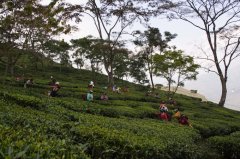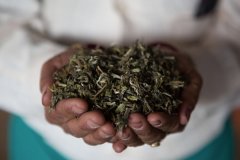What kind of black tea is better in India? Assam produces Organic Red Tea Banaspaty Tea Garden
For a long time, the tea garden built on the forest cover has been in a direct line of fire, and wild animals often sneak into the tea garden. Like elephant atrocities, leopard attacks on villages, hunters poaching unaccounted for one-horned rhinos, most areas are rife with violence, and animal and human losses are increasing. Inside and outside the tea garden, people began to build barbed wire, which prevented direct attacks, but not at all. The war will go on until someone decides to cease fire. Environmentalists, wildlife conservationists, tea garden managers and locals soon realized that the best way to end violence was to learn to share space. Since then, most tea gardens have made remarkable progress in maintaining a balance between the tea garden and the surrounding wildlife. Banaspaty tea Estate is one of the most important tea gardens in Assam, covering an area of 160 acres, located in the Karbi-Along Mountains of Upper Assam. Currently run by the third generation of tea farmers of the Mohan family, it is the first certified organic tea garden in Assam. Since its establishment in 1905, the garden has been trying to protect the surrounding natural animals and plants; coincidentally, Banaspaty literally means flora and fauna. The garden is close to the Kaziranga Forest Reserve, which allows herds of rhinos and elephants to enter the garden. As a result, the garden works with "wildlife enterprises" and Indian tea promoters to create a space for wildlife and humans. Wildlife Enterprise is an independent organization dedicated to protecting the global elephant population. The park draws a variety of activity corridors in various areas of the tea garden to facilitate elephant groups to move undisturbed without fear of poaching, injury or capture. The tea garden was certified as Elephant friendly ™, a certification based on WFEN and the University of Montana's broader influence on group cooperation. Plantations that meet the high standards of protecting elephant habitats and water resources, reducing human-elephant conflicts and mortality, and reducing barriers to elephant movement between elephant habitats are eligible for the certification. Ensure the elimination of fences, wires, gutters and other risks that may harm elephants, and eliminate the risk of elephant poisoning.

The farm also protects endemic tree species such as Hollong, Acacia, Khair and Mekai, which directly leads to the increase in Banaspaty wildlife and birds. Wreath hornbill, big Indian hornbill, dear, dwarf pig, leaf monkey, parrot, magpie and so on feed more than 400 workers and their families in one garden. The community is proud to be able to create a space for peaceful coexistence and work in sync with nature. Another garden that shows extraordinary sensitivity to its surroundings and has made considerable efforts to coexist with nature is Marguerite's Hope, one of Darjeeling's most romantic tea gardens. The tea garden is famous for panoramic views of the Himalayas and gourmet tea, but little is known about its efforts to protect the salamander population. The tea garden is full of lichens and orchids, as well as a lake, which is home to several species of salamanders. Dug up by L. Helegon in 1947 and by the then garden manager, Lake Salamander Bhanjyang Lake, the salamander, it has long attracted wildlife researchers from around the world to study this rare species. Considered a rare and endangered species, the Himalayan salamander is a member of the ancient salamander family, which is known to exist in Jurassic Europe. In India, they are found in Darjeeling, the Kamalang Valley, Ukhrul and the Senapati area of Manipur. Therefore, the conservation of these species has always been the most important, and this is an urgent garden to recognize and make the same response. In 1995, the lake was abandoned after an unfortunate drowning, but in 2003, someone tried to restore it for the sake of salamanders. 15000 species of aquatic life are added to the lake to promote the growth of salamanders. Today, the garden is rich in species. The efforts of these tea gardens to coexist with nature have had a more lasting impact, extending beyond the scope of the surrounding ecosystem. This impact has had a cultural and social impact, and more and more tea gardens have followed their example, recognizing the benefits of ending conflicts and peaceful coexistence. Despite the long road and much needs to be done, a step towards correcting centuries of friction is more effective than any other belligerent measure. This may be a story as old as time, humans and wildlife, but it is time to change the course of the story through better wildlife mitigation plans by conservation agencies and tea gardens.
Important Notice :
前街咖啡 FrontStreet Coffee has moved to new addredd:
FrontStreet Coffee Address: 315,Donghua East Road,GuangZhou
Tel:020 38364473
- Prev

What is the special taste of Goomtee summer picking black tea in Darjeeling Tutti Tea Garden? Characteristics of Darjeeling black tea
The huge Goomtee Tea Garden is located in the breathtaking mountains of the nine cities where the World Heritage toy train whistles are located. Only an hour and a half away from our facility in Siliguri, we came to this iconic tea garden and bought this exquisite fresh porcelain tea. This is a kind of at 400
- Next

What is the difference between the planting and taste of organic Darjeeling black tea in spring, summer and autumn?
Organic Darjeeling Tea Darjeeling, a small town famous for its amazing scenery, is the pride of India when it produces high-quality tea varieties such as black tea, oolong tea, green tea and white tea. It is home to many traditional gardens and has tea trees for more than 100 years. In 1841, Arthur Campbell put tea
Related
- The milk tea cup becomes smaller?! Overlord Tea Girl launches a new "Return to Yunnan" series
- Accused of selling counterfeit and high-priced coffee beans! Well-known boutique coffee brand "Oukelao" bowed and apologized!
- How to make espresso dumplings? Can I eat coffee and glutinous rice balls together?
- Save the unformed and stagnant powder cakes in one second! What is the problem with stagnant water in the powder bowl of the espresso machine?
- What does hand-brewed coffee stop mean? Why is it not recommended to make coffee by hand?
- Is it normal to smell like coffee? Why does coffee smell like alcohol? What's wrong with the strong smell of cold extract ice dripping ice brewed coffee?
- How to solve the problem that hand-brewed coffee extraction takes too long? Why is the water flowing so slowly when making coffee?
- The main points of making Australian white coffee, the proportion details, how does Australian white properly foam and blend the flowers?
- Can ice water make cold extract coffee? What is the difference between room temperature water and ice water for making cold coffee?
- What milk is best for making latte and white Dirty coffee? What is the difference between different brands of fresh milk and pure milk for making coffee?

